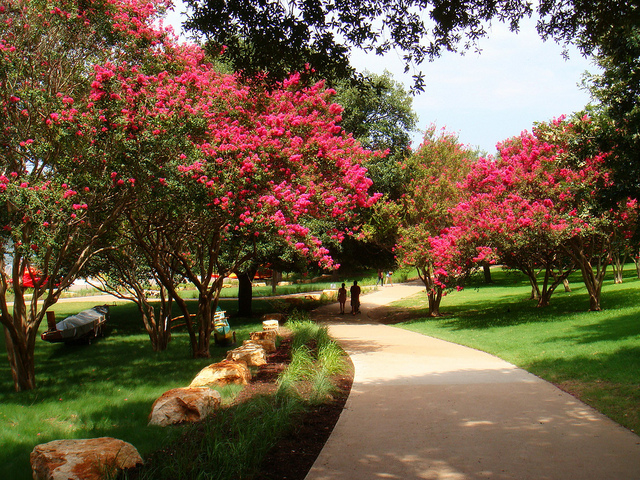Crape Myrtle in Austin, Texas; photo by CameliaTWU on Flickr (noncommercial use permitted with attribution / no derivative works).
Crape Myrtle
Texas designated the crape myrtle (Lagerstroemia indica) as the state shrub in 1997 (Texas also recognizes an official native shrub). All State Plants
Crape myrtles are among the toughest, most adaptable, and showiest plants that can be grown on Texas landscapes. The dark green leaves often turn orange or red in fall. Sometimes called "the Lilac of the South", and "perhaps the most beautifully branching flowering tree in the world."
The deciduous Crape Myrtle is among the longest-blooming shrubs (up to 120 days), and varies in size from dwarf to large shrubs or small trees. It has dense clusters of crinkled, crepe-papery flowers in white or shades of pink, red, or purple, and lives happiest in hot-summer climates.
HOUSE CONCURRENT RESOLUTION
WHEREAS, The crape myrtle has been a distinctive part of the Texas landscape for more than 100 years, and this striking shrub never fails to add a touch of class and beauty to its surroundings; and
WHEREAS, Many Texans appreciate the splendor of the crape myrtle and have taken a special interest in its proliferation in their communities, making it difficult to traverse our great state without witnessing the plant's annual summer flush of color; and
WHEREAS, Originally imported from China, the crape myrtle, Lagerstroemia indica, has thrived in the Lone Star State's often brutal climate, and the establishment of these hardy hybrids has done much to encourage tourism for many Texas cities while also bolstering civic pride among their residents; and
WHEREAS, In 1857, the wife of Confederate General Sam Bell Maxey introduced the crape myrtle to Paris, Texas, and in 1916, after a fire devastated this Northeast Texas town, one of the community's first beautification projects incorporated these colorful shrubs; several years later, newspaper publisher A. G. "Pat" Mayse further established the city's link to the plant when he sold thousands of crape myrtle seedlings for 25 cents each as Paris's residents prepared to celebrate Texas' centennial; and
WHEREAS, More recently, citizens planted crape myrtles along the 18 mile stretch of highway between Paris and the Texas Oklahoma border; this prominent display provides a distinctive welcome to travelers entering the Lone Star State from the north and offers a memorable Texas farewell to those individuals who must leave the friendly confines of our state; and
WHEREAS, The crape myrtle enjoys an equally prominent position in the annals of Waxahachie, where the Crape Myrtle Council has endeavored to further beautify this lovely city with the addition of 2,000 crape myrtles; community volunteers have rallied together to assist in the planting and maintenance of the shrubs in a region that already boasts a profusion of these unique plants; and
WHEREAS, Throughout the town, dazzling blooms subtly accent the rustic charm of Waxahachie's elaborate Victorian style homes, framing these stunning structures in a springtime explosion of red, white, pink, and lavender and enticing visitors from across the country to visit this historic city; and
WHEREAS, The rich soil of Brazos County is especially suited for growing these exquisite plants, and their foliage provides a dramatic complement to the county's magnificent oaks for many months each year; reflecting their concern for the natural beauty and ecology of their community, members of Brazos Beautiful, Inc., have planted crape myrtles in parks and public areas to promote a cleaner, healthier, and more attractive environment; and
WHEREAS, The organization's tireless efforts have greatly enhanced College Station's Richard Carter Park, where visitors can stroll along paths dotted with more than 20 varieties of crape myrtle, delighting in their showy blossoms; gracing urban areas and parklands throughout Brazos County, the crape myrtle has come to symbolize the community's sense of self esteem and civic cooperation; and
WHEREAS, The history of the crape myrtle is indelibly linked to Lamar County and the city of Paris, and its unique relationship with both Waxahachie and Brazos County is also well known among Texans; the citizens of these communities and the many organizations within them are to be commended as they continue in their efforts to promote the propagation of this enchanting plant in Texas; now, therefore, be it
RESOLVED, That the 75th Legislature of the State of Texas hereby formally recognize the valuable addition of the crape myrtle to our native flora and declare the crape myrtle the Official State Shrub of Texas; and, be it further
RESOLVED, That Lamar County be declared the Crape Myrtle County Capital and that Paris, its county seat, be designated the Official Crape Myrtle City for their longtime association with the celebrated shrub; and, be it further
RESOLVED, That Waxahachie be declared the Crape Myrtle Capital of Texas and that Brazos County be recognized as an Official Crape Myrtle County for their communities' lasting contributions to the beautification of Texas.

